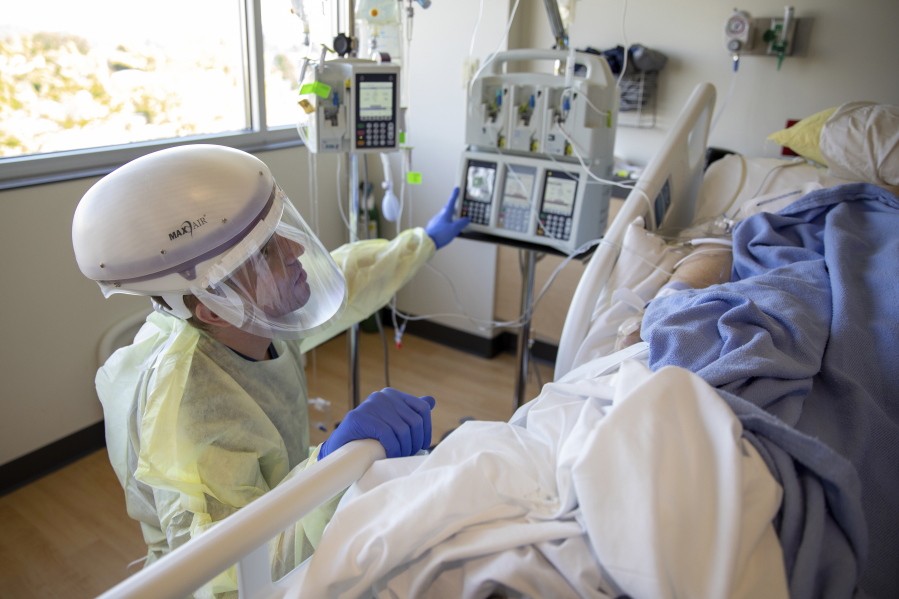BOISE, Idaho — When Idaho public health officials announced this week that northern hospitals were so crowded with coronavirus patients that they would be allowed to ration health care, roughly 11,000 kids in Coeur d’Alene were packing lunches, climbing on buses or grabbing backpacks for their first day of school.
Very few of them — maybe 2 percent or 3 percent, based on one district spokesman’s estimate — were wearing masks.
Kootenai Health, the hospital at the epicenter of the region’s COVID-19 health care crisis, is just a 10-minute walk from the Coeur d’Alene School District’s headquarters. It has 200 beds for medical or surgical patients, but on Wednesday — the second day of school — Kootenai Health’s doctors and nurses were caring for 218 medical and surgical patients, aided by military doctors and nurses called in to help with the surge.
On Thursday — the third day of school — the hospital tallied 109 COVID-19 patients, including 37 requiring critical care. The hospital normally has just 26 intensive care unit beds.
Meanwhile, Idaho’s vaccination rates remain among the lowest in the U.S., and coronavirus cases have grown by 44 percent in the last two weeks as the highly contagious delta variant burns through the population. It’s basically a math problem that adds up to a potential disaster.
“We’re at risk of getting more patients,” Dr. Robert Scoggins, Kootenai Health’s chief of staff, said during a news conference Wednesday afternoon. “There’s no mitigation in place in our school systems at this point, and I’m concerned about what’s going to happen …and how that will affect the care of COVID patients and non-COVID patients.”
School outbreaks have been a problem in other states with much higher vaccination rates than Idaho. More than 80 people at Kamiakin Middle School in Kirkland were told this week to stay home until notified because they came in contact with two students who tested positive for COVID-19. More than 85 percent of the eligible people in the area east of Seattle are fully vaccinated, according to local health officials.
And in Oregon’s Lake Oswego school district, more than 40 students are in quarantine because they were exposed to COVID-19 on a school bus. About 67 percent of adults are fully vaccinated in Clackamas County, where the school is located, according to state health officials.
In Kootenai County, which includes Coeur d’Alene, only 41 percent are fully vaccinated. Still, like the vast majority of school districts in northern Idaho, Coeur d’Alene is not requiring masks or other steps to prevent the spread of coronavirus.
Many in the extremely conservative region have been adamantly opposed to mask mandates since the pandemic began. During one Coeur d’Alene school board meeting last month, some attendees held signs, booing or cheering the speakers. Three of the five school board members said they preferred to recommend wearing masks as a personal choice.
“We are highly concerned. I mean, we’re already seeing the effects of the delta variant,” said Panhandle District Health spokeswoman Katherine Hoyer on Thursday. “This is really going to take our community being responsible to protect each other and our health care facilities. We never wanted to reach crisis standards of care, yet here we are.”
During last winter’s surge, the Panhandle Health District worked with schools on contact tracing. Hoyer said the Coeur d’Alene School District was especially helpful for cases involving students.
But this year, the public health district has jettisoned traditional contact tracing after the case backlog became hopelessly huge. Now the agency does smaller investigations for priority populations only: health care providers, long-term care facility residents and workers, and students and school staffers.
Coeur d’Alene School District spokesman Scott Maben said the district has also ended contact tracing.
“We don’t have the resources to do it this year,” Maben said. “We are definitely relying on people to self-report to us.”
That could be a problem. Hoyer’s agency has run into several families that refuse to say which school their COVID-19-positive child attends. Last school year, Maben saw families knowingly send kids with COVID-19 to school and extracurricular activities.
The school district can send the child home for mandatory quarantine if it knows about a positive coronavirus test, but again, relies on families to disclose the information.
“We’re urging people to stay home until it’s safe to be around others, but we also know that a lot of families believe that a lot of these concerns are exaggerated and their kids need to be in school,” Maben said. “That’s an ongoing frustration with us.”



